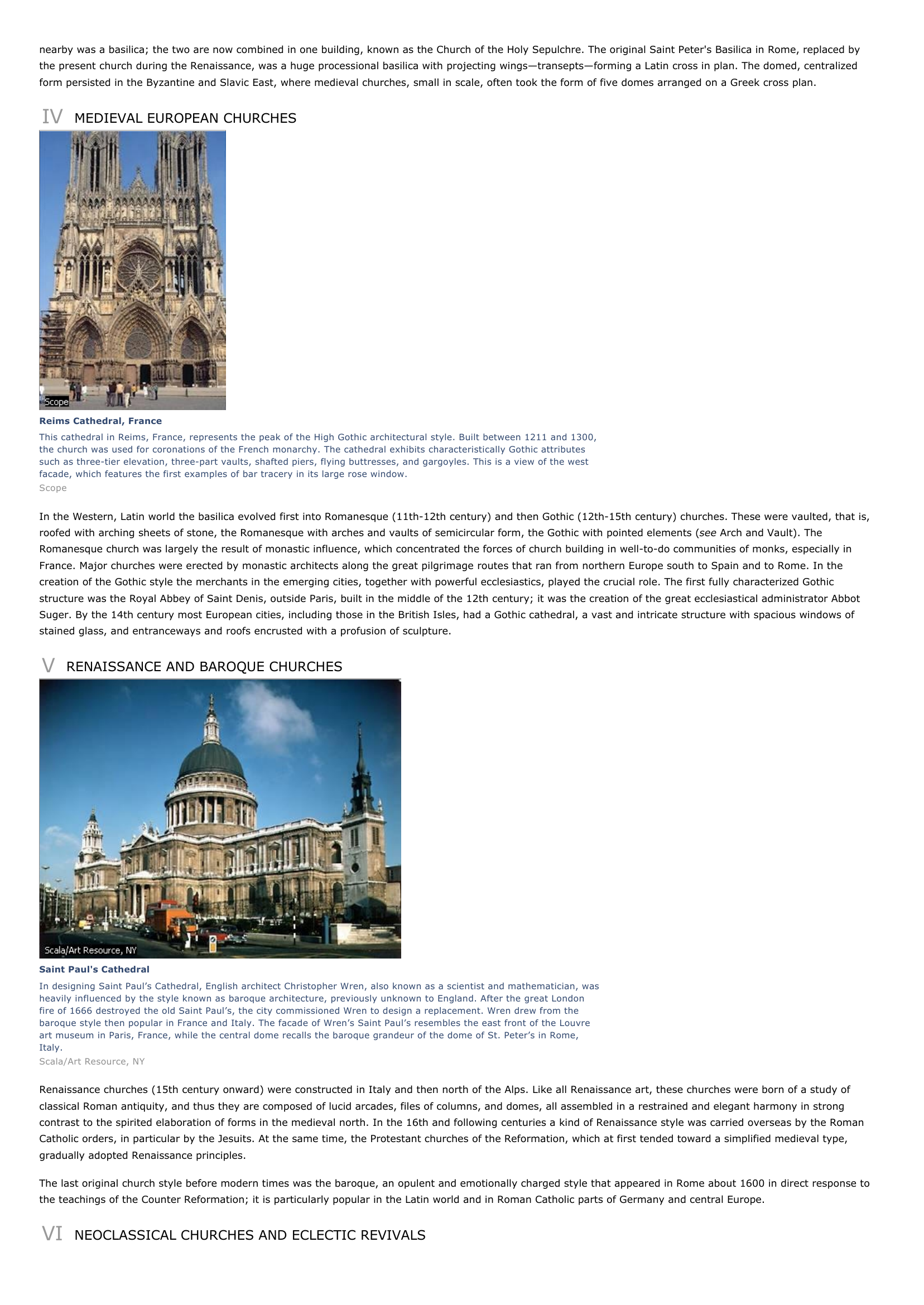Church (building) I INTRODUCTION Church (building), a building designed for worship for groups of Christians.
Publié le 12/05/2013

Extrait du document
«
nearby was a basilica; the two are now combined in one building, known as the Church of the Holy Sepulchre.
The original Saint Peter's Basilica in Rome, replaced bythe present church during the Renaissance, was a huge processional basilica with projecting wings—transepts—forming a Latin cross in plan.
The domed, centralizedform persisted in the Byzantine and Slavic East, where medieval churches, small in scale, often took the form of five domes arranged on a Greek cross plan.
IV MEDIEVAL EUROPEAN CHURCHES
Reims Cathedral, FranceThis cathedral in Reims, France, represents the peak of the High Gothic architectural style.
Built between 1211 and 1300,the church was used for coronations of the French monarchy.
The cathedral exhibits characteristically Gothic attributessuch as three-tier elevation, three-part vaults, shafted piers, flying buttresses, and gargoyles.
This is a view of the westfacade, which features the first examples of bar tracery in its large rose window.Scope
In the Western, Latin world the basilica evolved first into Romanesque (11th-12th century) and then Gothic (12th-15th century) churches.
These were vaulted, that is,roofed with arching sheets of stone, the Romanesque with arches and vaults of semicircular form, the Gothic with pointed elements ( see Arch and Vault).
The Romanesque church was largely the result of monastic influence, which concentrated the forces of church building in well-to-do communities of monks, especially inFrance.
Major churches were erected by monastic architects along the great pilgrimage routes that ran from northern Europe south to Spain and to Rome.
In thecreation of the Gothic style the merchants in the emerging cities, together with powerful ecclesiastics, played the crucial role.
The first fully characterized Gothicstructure was the Royal Abbey of Saint Denis, outside Paris, built in the middle of the 12th century; it was the creation of the great ecclesiastical administrator AbbotSuger.
By the 14th century most European cities, including those in the British Isles, had a Gothic cathedral, a vast and intricate structure with spacious windows ofstained glass, and entranceways and roofs encrusted with a profusion of sculpture.
V RENAISSANCE AND BAROQUE CHURCHES
Saint Paul's CathedralIn designing Saint Paul’s Cathedral, English architect Christopher Wren, also known as a scientist and mathematician, washeavily influenced by the style known as baroque architecture, previously unknown to England.
After the great Londonfire of 1666 destroyed the old Saint Paul’s, the city commissioned Wren to design a replacement.
Wren drew from thebaroque style then popular in France and Italy.
The facade of Wren’s Saint Paul’s resembles the east front of the Louvreart museum in Paris, France, while the central dome recalls the baroque grandeur of the dome of St.
Peter’s in Rome,Italy.Scala/Art Resource, NY
Renaissance churches (15th century onward) were constructed in Italy and then north of the Alps.
Like all Renaissance art, these churches were born of a study ofclassical Roman antiquity, and thus they are composed of lucid arcades, files of columns, and domes, all assembled in a restrained and elegant harmony in strongcontrast to the spirited elaboration of forms in the medieval north.
In the 16th and following centuries a kind of Renaissance style was carried overseas by the RomanCatholic orders, in particular by the Jesuits.
At the same time, the Protestant churches of the Reformation, which at first tended toward a simplified medieval type,gradually adopted Renaissance principles.
The last original church style before modern times was the baroque, an opulent and emotionally charged style that appeared in Rome about 1600 in direct response tothe teachings of the Counter Reformation; it is particularly popular in the Latin world and in Roman Catholic parts of Germany and central Europe.
VI NEOCLASSICAL CHURCHES AND ECLECTIC REVIVALS.
»
↓↓↓ APERÇU DU DOCUMENT ↓↓↓
Liens utiles
- George Frideric Handel I INTRODUCTION Handel's Water Music In addition to his popular operas and oratorios, German-born composer George Frideric Handel wrote music in the 1700s for the church and for royal celebrations.
- Toys. I INTRODUCTION Toys, objects that serve as playthings for children. Although the
- Rex I INTRODUCTION Rex, a common name for any of three distinct breeds of curly-coated cat: the Cornish rex, the Devon rex, and the Selkirk rex.
- Golf. I INTRODUCTION Golf, outdoor game in which individual players use specially designed
- Animation I INTRODUCTION Finding Nemo A clown fish named Marlin, left, and his friend Dory search for Marlin's son in the computer-animated feature film Finding Nemo (2003).

































